
Monday February 6, 2023
By ABDIRAHMAN MOHAMED
Starting out years ago, photographer Mohamud Mumin and colleagues missed the community of other Somali artists and a venue to exhibit their work. So they created it themselves.
Soomaal House of Art co-founder Mohamud Mumin attends an artist’s exhibition January 7, 2023, in the facility’s gallery. Mohamud and two colleagues started Soomaal to build a sense of community and give Somali artists a place to exhibit their work. Credit: Abdi Mohamed | Sahan Journal
As an artist, Mohamud Mumin has enjoyed much personal success, including winning multiple fellowships for his work in photography. But there were always a couple things missing: Enough opportunities to exhibit at mainstream Twin Cities galleries, and other Somali artists or artists of color to share the experience.
So he gravitated toward those with a similar background, eventually teaming up with visual artists Kaamil Haider and Khadija Muse to found the Soomaal House of Art in 2014.
The three have worked over the years to develop a space to showcase their work, while mentoring and curating a community of local artists. That led two years ago to the launch of a fellowship with Augsburg University Art Galleries and the introduction this year of a residency program to support Somali artists.
For Somali artists trying to establish themselves in the Twin Cities, their efforts have made a difference. Multidisciplinary artist Aesha Mohamed said that for her, finding Soomaal House was like a lone wolf finally finding its pack.
The need for a space
At its core, the idea for Soomaal House came from the desire of the three founders to make it easier for Somali artists to share their work. For most, more established galleries in the Twin Cities weren’t an option, said Mohamud.
“A lot of those opportunities usually are locked away from us in the mainstream institutions,” he said. “The mainstream institutions now come to you when they have their own agenda in an almost tokenizing way.”
Before they moved into their current space at the corner of 22nd Street and Minnehaha Avenue in Minneapolis five years ago, Soomaal hosted shows across the state in mosques, schools, yoga studios, and other locations.
Their inaugural exhibit, “Anomalous Expansion,” in 2016 at the Darul Uloom Islamic Center in St. Paul featured video, performance art, painting, and photography by six Somali artists from Minnesota. The enthusiastic reaction propelled them to find a permanent gathering space for artists and the broader community.
What the space means for artists
Khadija Charif came to Soomaal as a volunteer early, as she developed her work in poetry and photography. English didn’t necessarily come easy for her as a young native Somali speaker, but she realized that poetry wasn’t bound by the conventions of any language. She then picked up photography at age 12, and has developed her craft in both mediums over the years.
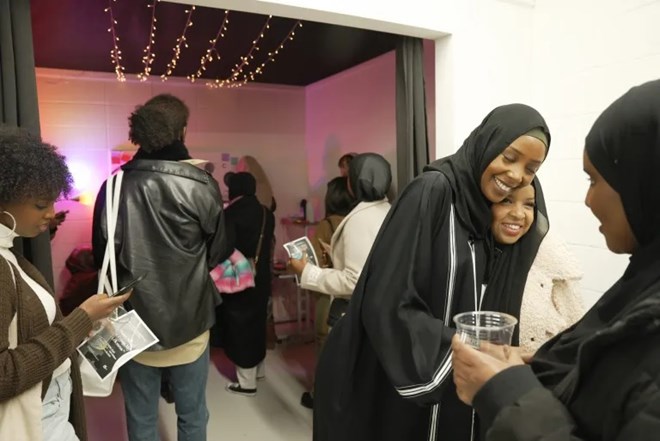
Khadija Charif hugs a friend at an artist’s exhibit at Soomaal House on January 7, 2023. As the marketing and communications director, she works to provide artists with resources and plan marketing strategies. Soomaal House exists to provide resources, community and opportunities to artists, she says.
Now Soomaal’s director of marketing and communication, Khadija Charif reaches out to artists and individuals who are looking to contribute to Soomaal. She works closely with Wasima Farah, a visual artist who serves as Soomaal’s graphic designer and creative strategist.
Wasima also began her journey as an artist at a young age. While she started creating art at 16, it wasn’t until her senior year of high school in 2016 that she shared her work online. The founders of Soomaal took notice.
“I never exhibited my work before so it was a nice experience,” Wasima said. ” And from there we just had a good relationship.”
It was one thing for Wasima to show her art online; quite another to exhibit her paintings and receive immediate audience feedback.
“I got to actually talk about the things that went behind my work, which was very scary and vulnerable,” she said. “I’ve never been able to do that until I got to Soomaal House, and it’s a space where it feels comfortable to do so.”
Interacting with gallery visitors and fellow artists gave her the ability to take a deeper look at her works and provide insights into her intentions.
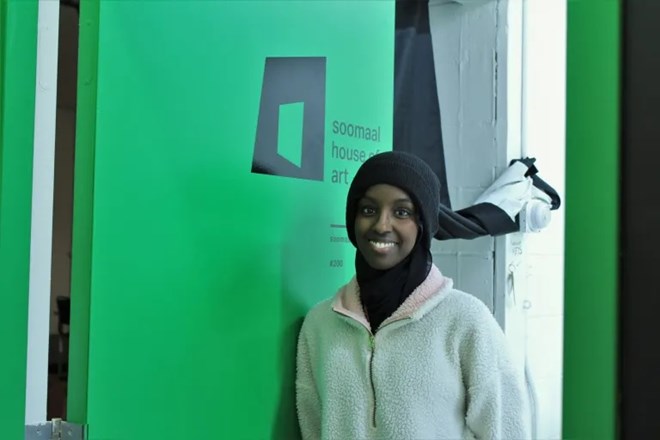
As the creative strategist of Soomaal House of Art, Wasima helps emerging artists hone their aesthetic and build a concept around their exhibits. Interacting with gallery visitors and fellow artists helped her take a deeper look at her own works, she says. Credit: Abdi Mohamed | Sahan Journal
In her exhibit “Growing Pains,” Wasima explored the coming-of-age theme through primary colors that she associated with different emotions and timestamps.
“I made characters from mostly colors that helped me process my own life. So yellow would be the child, she’s full of hope, and then red would be the opposite. She’s the mother full of anger, full of wisdom. And blue is vulnerable and honest. So yellow is the past, red is the future. And blue is the present,” she said.
Filmmaker Mohamed Shaykh also found audience feedback helpful. He was introduced to the space through a short film project that was part of Wasima’s exhibit. Since then he’s held multiple screenings of his short films to predominantly Somali audiences.
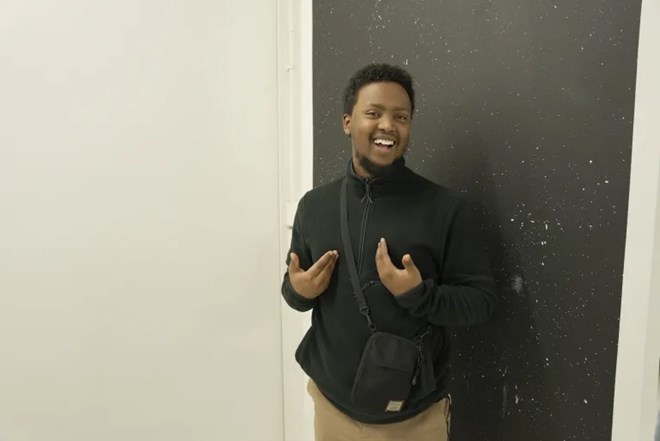
Filmmaker Mohamed Shaykh laughs with friends while attending Aesha Mohamed’s exhibit “A Moon Shall Rise from My Darkness,” at Soomaal House of Art on January 7, 2023. Mohamed and Aesha are among four artists chosen for Soomaal House’s first residency program. Credit: Abdi Mohamed | Sahan Journal
Prior to Soomaal, Shaykh finished projects without organizing a formal screening.
“Because I didn’t know who my audience was, I was like, ‘I made the film, I learned some lessons, I might as well just screen it to my friends,’” he explained. They would watch it together in someone’s home, and then he would put it on YouTube. But last year, Mohamed screened two short films at Soomaal titled “Bill The Driver” and “Luul.” While his previous screenings amongst friends resulted in kind words and compliments, the screenings at Soomaal allowed his viewers to connect to his work.
“It’s a unique experience for them to be able to see themselves on the screen,” he said.
Mentorship and Developing artists
At 42 years old, Mohamud Mumin is now an established artist with awards including the McKnight Artist Photography Fellow. But growing up, he and his peers had few places to turn with questions. Many of the notable Somali artists in the United States were in different cities or traveling. Their need for mentorship was what motivated Soomaal’s founders to make artist development a core part of their mission.
In addition, they encouraged the audience to grow with them, learning why artists do what they do. They fund Soomaal House with a mix of grants and private donations.
Khadija Charif has worked with Mohamud for several years and considers him a mentor for technical and artistic questions in her photography work. She now sees herself in a position to mentor others. “It’s gotten to a point where I can also do that for any friends of mine who are interested in the art world,” she said.
At Soomaal House, Aesha Mohamed said felt at home among a group of Somalis, like a lone wolf finding her pack. She first connected with Khadija Charif right around the time that she was planning to release her book of poems, (Love) Letters to, Him.
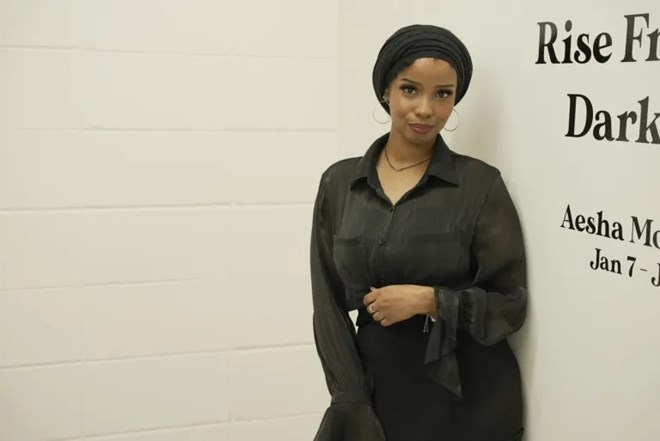
Soomaal House resident artist Aesha Mohamed poses for photos near the front of her exhibit “A Moon Shall Rise from My Darkness” following the opening reception on January 7, 2023. In a new program, Aesha will be one of four resident artists at Soomaal House this year. Credit: Abdi Mohamed | Sahan Journal
“She’s very charismatic and just fun. And when you talk to her, it just feels like a warm hug,” Aesha said. She encouraged Aesha to do a book launch at Soomaal, even though she was not well known. “ These people don’t even know me,” Aesha recalled, “But they have so much faith in me that it helped me have faith in myself.’”
For Khadija Charif, this is exactly what Soomaal House is about.
“The entire intention of Soomaal House is to not gatekeep,” she said. “It’s to provide services, to extend our hands, to allow people to come to a space and feel the space as an area to find resources, and to find individuals who have similar interests, and to find opportunities.”
Fellowship and Residency
Khadija Charif felt that support herself as a fellow in Soomaal’s partnership with Augsburg University Art Galleries. The 12-month program gives two artists access to studio space and technical assistance. Their work during the fellowship leads to an exhibition at the university.
The exhibits by Khadija Charif and a second artist, Yasmin Yassin, showcased photographs, poetry, and projections relating to the early months of the pandemic. Although Khadija Charif had been practicing her craft for years, taking part in the fellowship helped her gain confidence in her work.
“Although I’ve had 10 years of work in my pocket and 10 years of experience, and then a few years of exhibition support, nobody really understands what an exhibition holds until you become part of that,” she said.
Before creating a fellowship with an outside entity, Mohamud said Soomaal wanted to be sure that it would help the artists find future opportunities and apply for grants that required prior experience exhibiting their work. Consistent engagement with Soomaal can be a good indicator that an artist takes themselves seriously, and is intent on developing, he said.
This year Soomaal is introducing its residency program, which will be aimed at four artists from different disciplines. Mohamed Shaykh and Aesha Mohamed are a part of the inaugural cohort, and are set to receive monetary and technical support over the next year. Each will receive $2,500 to offset some of the costs of producing their work.
The residency should help connect artists to mentors, provide studio space and receive feedback on their work. Mohamed is looking forward to it.
“They can put me in touch with that professor, or they can put me in touch with some of the community members that I normally wouldn’t be able to get a chance to network with,” he said.
Mohamud said the artists were singled out because of their sustained work and engagement with Soomaal.
“These are artists that we’ve worked with numerous times and we see a lot of potential in them,” he said. “The product is not the goal, but the journey of getting to the artwork is the goal.”
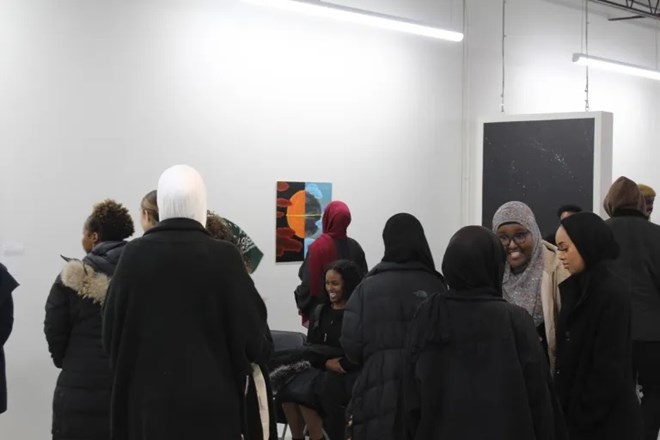
Visitors chat and appreciate art at Soomaal House during a showing of Aesha Mohamed’s exhibit “A Moon Shall Rise from My Darkness” on January 21, 2023. Credit: Abdi Mohamed | Sahan Journal
Fostering community
Soomaal also has enjoyed an uptick in community engagements and visitors to its galleries this year, which Khadija Charif sees as a reflection of the need within the Somali community. “The community wishes to have things like this happen, where people can share their stories and advocate for themselves and share their work and talk about sensitive topics,” she said.
Because of this growing sense of reliance on Soomaal House from the community, Mohamud believes that it cannot be the only space of its kind. There need to be more.
“If you have one doctor or one surgeon or one teacher you know that the village is in danger. ‘Cause you take away that one person then everything falls flat so we are aware of that in the back of our head,” he said.